Best Movies Based On Novels – Top 10 Adaptations
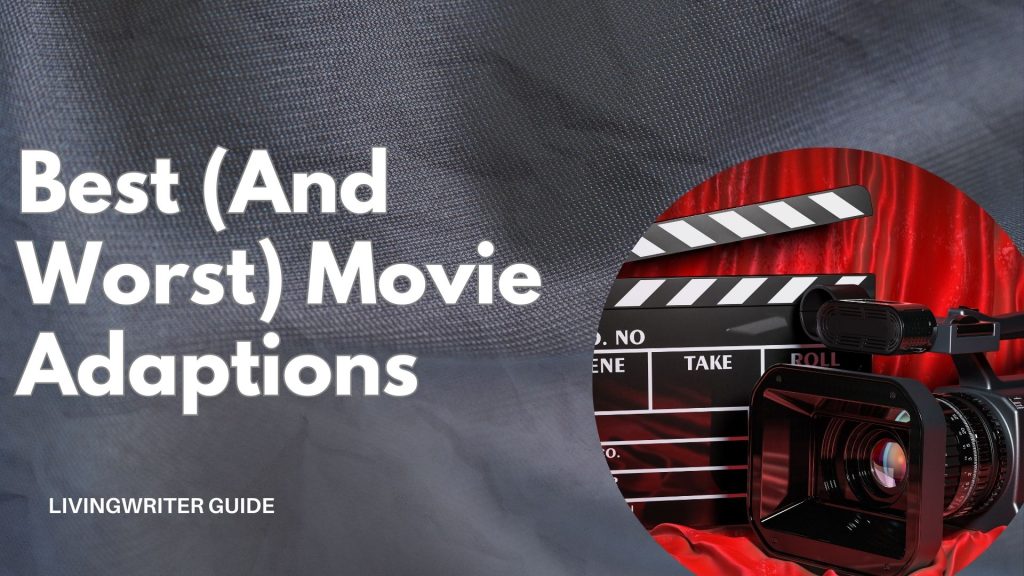
Novels and film are two different mediums, but plenty of movies are based on books. In fact, some of the most popular films of all time are based on books. But adapting an excellent book to an equally good movie is an art, and sometimes, it doesn’t go well. Today, I’ll look at the best movie adaptations of all time and what they did right.
In addition to the top adaptations of all time, I’ll also look at some instances where the movie did not transfer to the screen well. By the end of today’s article, you’ll have an idea of what goes into a good adaptation and how you can turn your novel into a screenplay. So, without further ado, let’s get started.
Table Of Contents
Best Movies Based On Novels
10. Arrival
Arrival is a science fiction film based on Ted Chiang’s short story “Story of Your Life.”The film follows linguist Louise Banks, as she works with the military to communicate with aliens who have arrived on Earth.
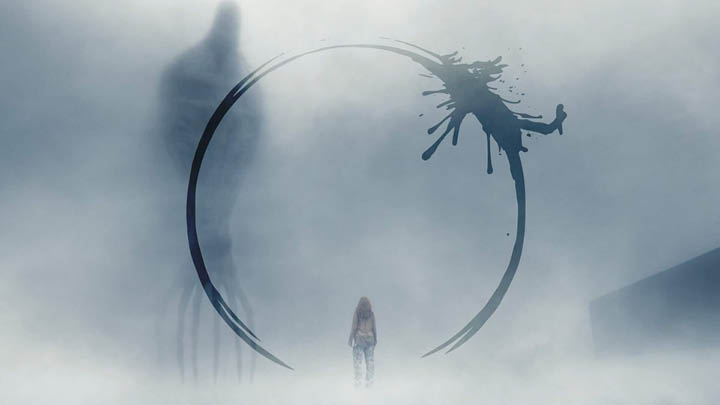
The movie captures the core themes of the short story: the nature of language, the perception of time, and the impact of human connection. The visuals are stunning and the depiction of the alien language is done exceptionally well and does a lot to enhance the story’s impact.
You May Also Like: 12 Common Beginner Writing Mistakes You Must Avoid
The film creates a believable world where humanity is genuinely grappling with the unknown without needing excessive exposition. It also does this via unconventional storytelling techniques, like presenting a non-linear narrative that unfolds through time and memory.
Overall, Arrival is a prime example of a successful adaptation. It stays true to the heart of the source material but elevates it through legitimate cinematic storytelling.
9. No Country for Old Men
The Coen brothers’ film No Country for Old Men is a masterful adaptation of Cormac McCarthy’s novel of the same name.
The story is about a hunter who stumbles upon a drug deal gone wrong and takes a large amount of money left there, a mysterious killer hellbent on retrieving the money, and a sheriff trying to solve the crime.
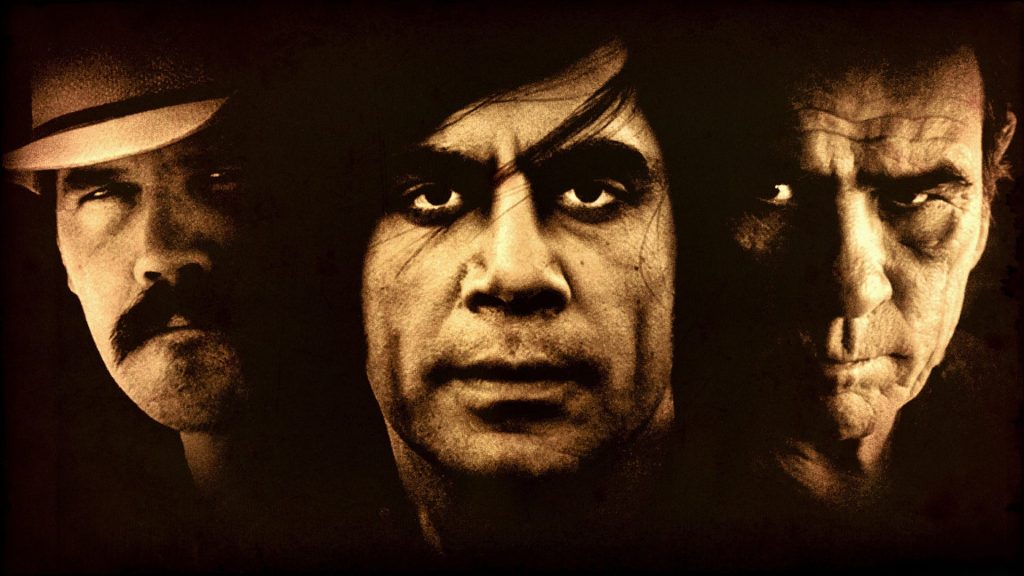
The film captures the tense and morally ambiguous world of the novel. At the same time, the Coen brothers’ style and minimalist dialogue perfectly complement the original work.
The film delves into themes of fate, chance, and the consequences of violence and avoids easy answers while exploring these complexities. And the performances of Javier Bardem as Anton Chigurh and Tommy Lee Jones as Sheriff Ed Tom Bell are particularly noteworthy in conveying the characters.
8. The Silence of the Lambs
Jonathan Demme’s adaptation of Thomas Harris’s “The Silence of the Lambs” is a psychological thriller that successfully captures the dark world of the novel. The film follows FBI trainee Clarice Starling as she seeks the help of the incarcerated serial killer Hannibal Lecter to catch another serial killer known as Buffalo Bill.

The film masterfully balances suspense, horror, and psychological intrigue, leading to a tense and unsettling atmosphere. Iconic performances from Jodie Foster and Anthony Hopkins (whose portrayal of Hannibal Lecter is one of the most memorable villains in cinema history) really translate a lot of personality to the screen.
Overall, the adaptation effectively captures the novel’s best themes while also adding its own unique cinematic flair. When you put all of this together, you’ve got a very well-executed book-to-movie adaptation.
You May Also Like: Most Overused Horror Cliches – Top 10
7. The Green Mile
Frank Darabont’s The Green Mile brings Stephen King‘s novel to life. The story follows Paul Edgecomb, a death row corrections officer as he witnesses a series of miraculous events involving a mysterious inmate named John Coffey.
In typical king fashion, the film blends the elements of fantasy, drama, and suspense, creating a beautiful and emotionally charged experience. For example, the miraculous healing powers of John Coffey feel grounded in realism. And the scenes where Coffey heals illnesses and injuries feel down-right awe-inspiring and emotionally resonant.
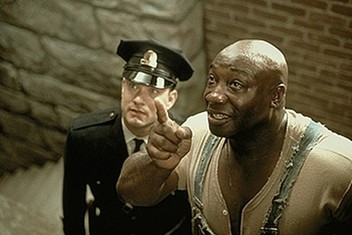
The performances are exceptional too, particularly Tom Hanks (as Paul Edgecomb) and Michael Clarke Duncan (as John Coffey.) The film manages to show Coffey’s gentle and childlike nature while also highlighting his immense power. Michael Clarke Duncan’s performance brings this complex character to life, making him both sympathetic and fearsome.
You May Also Like: How To Write Unique Characters With LivingWriter
By carefully adapting King’s complex novel, Darabont was able to create a film that is both faithful to the source material and a powerful cinematic experience in its own right.
6. Schindler’s List
Schindler’s List is a historical drama that tells the true story of a German businessman who saved the lives of hundreds of Jews during the Holocaust.
The film really captures the horrors of the times but also highlights acts of courage and compassion. It is shot in black-and-white, which complements the themes of the movie well. Given the nature of the subject matter, it would have been easy to resort to sensationalism or exploitation. However, the film maintains a respectful and dignified tone throughout.
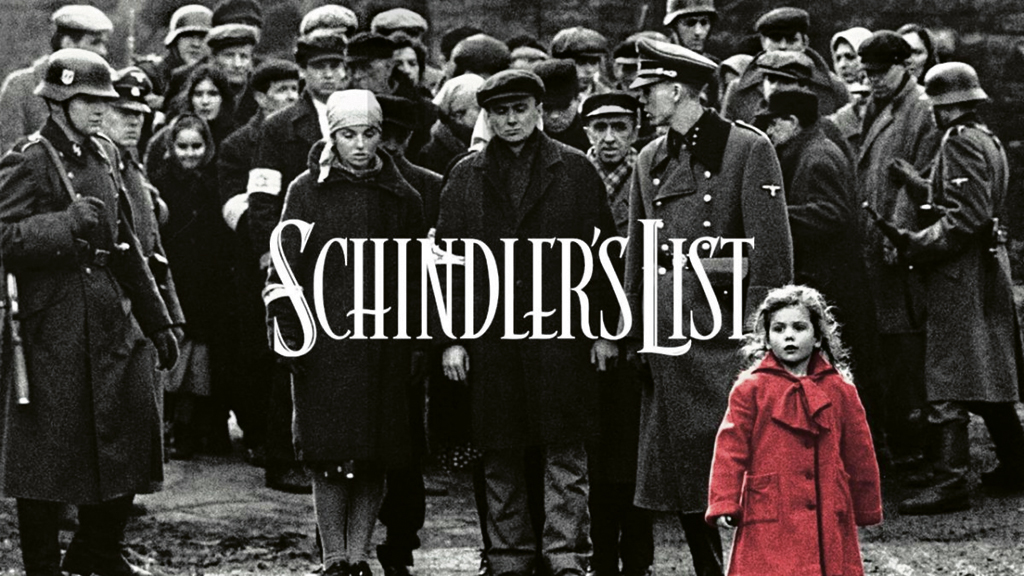
The film also managed to avoid one-dimensional characters. For example, portraying the Nazi officers as purely evil and the Jewish characters as passive victims. Instead, the film explores the complexities of human nature.
And finally, as a historical drama, it was crucial to accurately depict the events of the Holocaust. Any inaccuracies or distortions could have undermined the film’s credibility. By combining historical accuracy, powerful performances, and a strong emotional core, Schindler’s List is considered one of the greatest films ever made and a testament to the power of cinema to educate and inspire.
5. One Flew Over the Cuckoo’s Nest
One Flew Over the Cuckoo’s Nest is an adaptation of Ken Kesey’s novel by the same name. The story follows Randle McMurphy, a rebellious anti-hero who feigns insanity to avoid prison time and is committed to a mental institution.
The film shows the oppressive atmosphere of the mental ward and the patients’ struggle for individuality and freedom. Jack Nicholson’s performance as McMurphy is both charismatic and tragic. Director Milo Forman went above and beyond to remain faithful to the original work and convey the things that made the novel special.
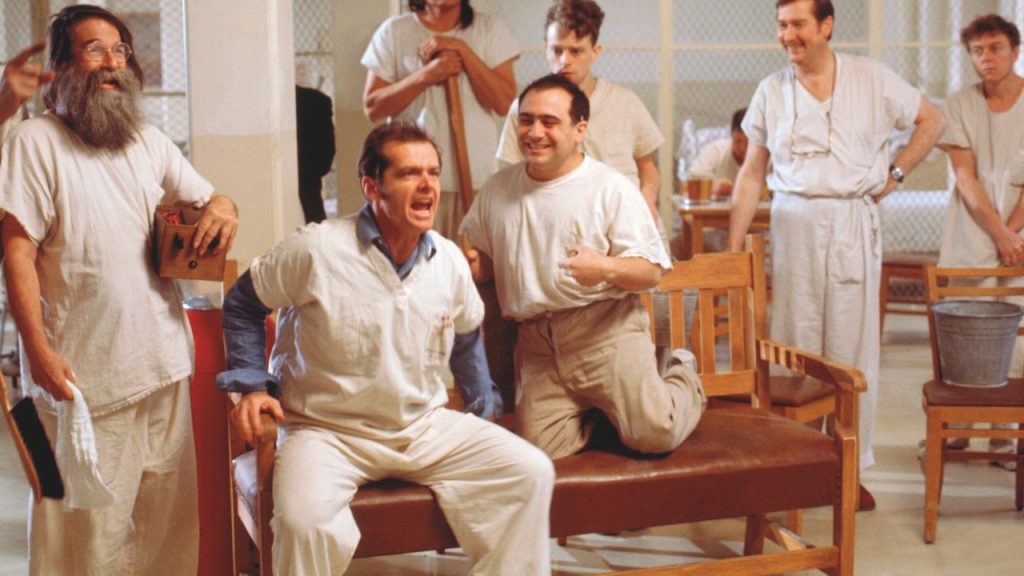
The film was shot in an actual mental hospital (Oregan State Hospital), which is still in use today. The hospital’s director even gave each of the actors a patient to “shadow.” The hospital also asked for patients to be allowed to help with the film as crew, and the producers agreed, not knowing that many of them were criminally insane.
For the group therapy scenes, Forman used three cameras to record all shots for the scene at the same time. This was not commonly done at the time (and was expensive), but it allowed them to get the actors’ authentic reactions to each other.
Overall, the film stays true to the core of the novel. And the cast put on amazing performances that brought the characters to life. Plus, the authenticity of filming in a real mental ward did a lot to present the oppressive atmosphere in the novel. Put all this together and you have not only one of the best movies based on novels but one of better movies ever made.
4. Forrest Gump
Director Robert Zemeckis’ Forrest Gump is a heartwarming and humorous film adaptation of Winston Groom’s novel. The film follows the life of Forrest Gump, a simple-minded but kind-hearted man who witnesses and participates in many of the most significant historical events of the late 20th century.
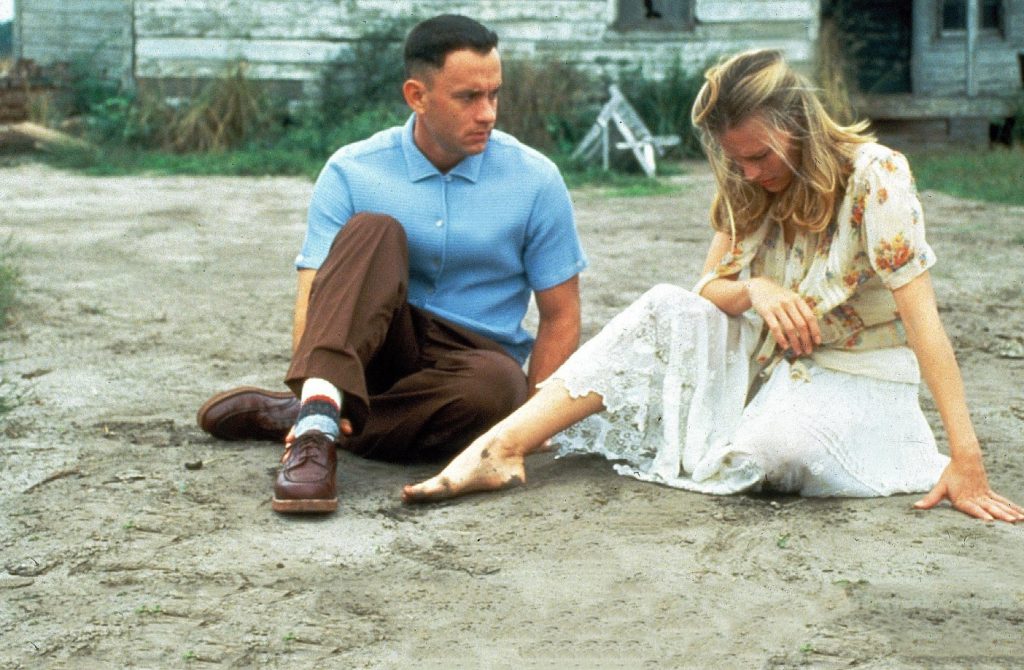
The film’s success lies in being legitimately humorous, highly dramatic, and downright heart-warming. Tom Hanks’ performance as Forrest Gump is both endearing and poignant. The film used special effects to put Forrest into actual archived footage of historical events. Considering this was very well done, it’s no wonder that many of the scenes are so visually striking.
Between this and the soundtrack (which reflects different periods throughout the movie), the film evokes a sense of nostalgia for the past, even for those who didn’t experience it firsthand. The simple (but effective) narrative structure and Forrest’s childlike perspective make the plot accessible despite it being emotionally impactful.
The humor, the grit, Forrest as a character, and many other things combine to make Forrest Gump the beloved classic it is.
3. The Shawshank Redemption
The Shawshank Redemption, directed by Frank Darabont (who also did The Green Mile), is a phenomenal adaptation of Stephen King’s novella “Rita Hayworth and Shawshank Redemption.” The film follows Andy Dufresne, a banker wrongly convicted of murder, as he endures decades of imprisonment and eventually orchestrates a daring escape.
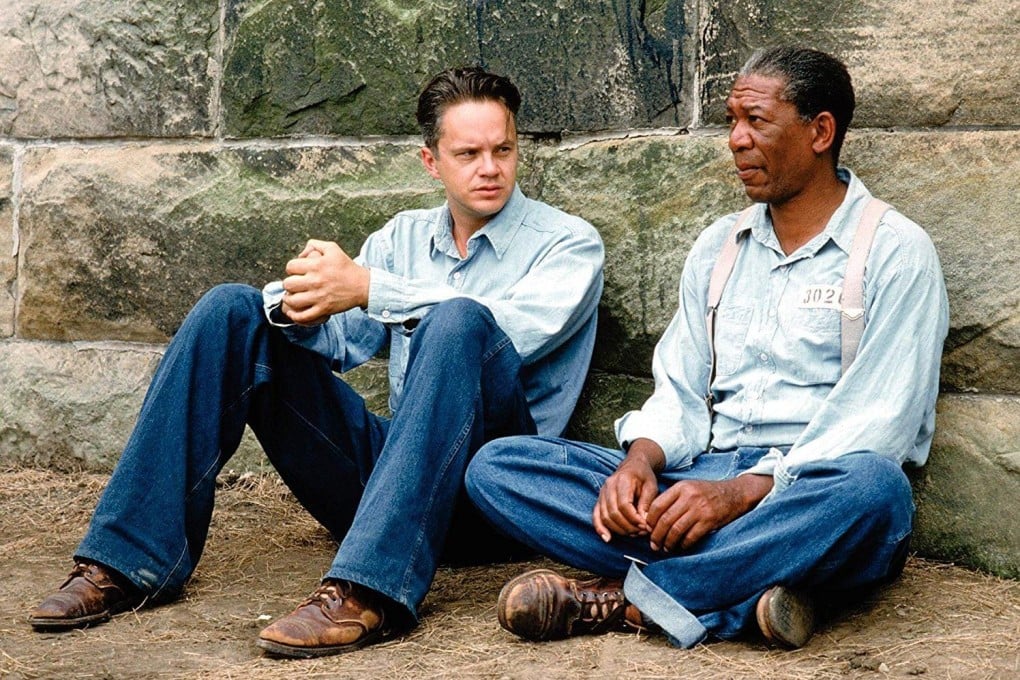
The film’s success can be credited to many things. First, how well it conveys the story and captures themes of hope, friendship, and the human spirit. The acting is superb, and Tim Robbins delivers a powerful performance as Andy Dufresne while Morgan Freeman’s portrayal of Red is both wise and humorous.
The film is also unique in regards to Andy and Red’s relationship. It’s a more pure form of friendship than you don’t see in many movies. Stating, “The friendship is not built on conducting a caper, car chases, or developing a relationship with women.” philosopher Alexander Hooke made the case that Andy and Red’s friendship and the joy they bring one another is a sort of freedom for them.
2. The Godfather
Francis Ford Coppola’s The Godfather is regarded as a cinematic masterpiece that perfectly captures Mario Puzo’s popular novel. The film follows the Corleone family, a powerful Mafia family, navigating the treacherous world of organized crime.
The film’s success lies in its complex characters, strong performances, and its exploration of themes of family, power, and loyalty. Marlon Brando’s performance as Vito Corleone is one of the most memorable in film history, and Al Pacino’s portrayal of Michael Corleone is equally iconic.
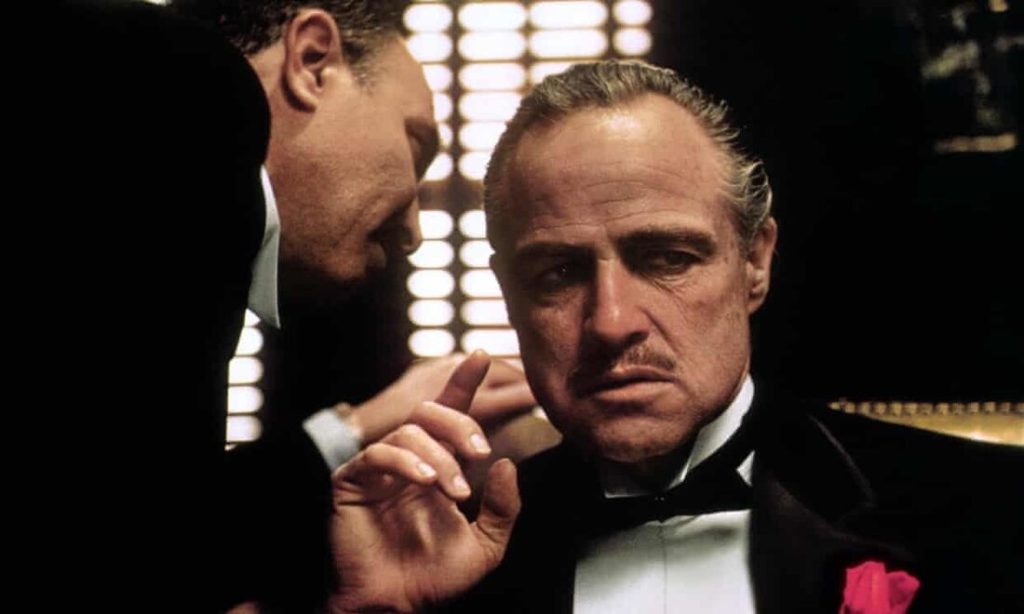
Mario Puzo and Francis Ford Coppola both wrote their own version of the screenplay and collaborated throughout the process to make sure all of the key elements from the novel made it to the screen. And they went to great lengths to ensure that the characters (and Italians in general) were authentic and well represented.
This went as far as producer Albert Ruddy meeting with the head of the Columbo crime family’s son on numerous occasions throughout production, which influenced the characters’ being loosely based on certain real-life individuals. However, Ruddy was made to promise to remove all instances of “Mafia” and “Cosa Nostra” from the script, which he did.
The characters are complex and morally ambiguous, making them both fascinating and relatable. The film explores themes of family, power, and corruption with depth and nuance. Coppola’s visual style is both gritty and elegant and the pacing is deliberate and methodical, building tension and suspense.
By striving for an authentic story, staying faithful to the source material, and adding his own unique cinematic flair, Coppola created one of the greatest movie adaptations of all time. He created a timeless classic that continues to influence filmmakers and audiences alike.
Oh, and Mario Puzo’s other novels are actually great, too. I highly recommend you check them out if you’re into mafioso stories.
1. The Lord of the Rings Trilogy
In the number one spot, we have The Lord of the Rings. Peter Jackson’s trilogy brings J.R.R. Tolkien’s epic fantasy world to life. The films follow the journey of Frodo Baggins as he seeks to destroy the One Ring and defeat the Dark Lord Sauron.
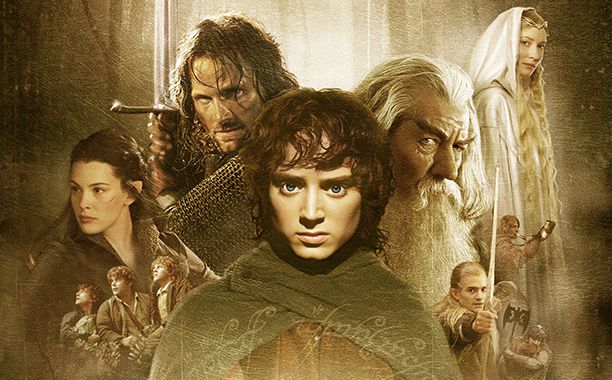
The films somehow manage to capture the magic and wonder of Tolkien’s enormous world. In general, the movie stays true to the spirit of Tolkien’s novels, mythology and storytelling.
However, if you’ve read the book, you’ll agree that it wouldn’t have worked well if it had been adapted to the screen exactly as it was written. That said, Jackson made good decisions when choosing what changes to make. He managed to keep all of the things that made the book(s) great and kept it well-paced.
You May Also Like: Most Overused Fantasy Tropes – Top 10
And while deviating from the original work is always noteworthy, many fans feel that specific changes (like adding depth to Aragorn and Arwen) turned them into important characters instead of almost plot devices for the story.
What Makes a Good Adaptation?
A successful adaptation is an ever-delicate balance between honoring the source material and translating it effectively to a new medium – The Screen. Based on the top 10 list of successful adaptations, here are some key factors that contribute to a great adaptation:
1. Fidelity to the Source Material
When you’re adapting a book to a movie, one of the most important things is to stick to what happens in the book. Of course, some changes will have to be made in order to adapt it. But generally, when someone loves a book, they want the movie to be as close as possible.
This falls into two major categories:
- Core Themes and Ideas: The adaptation should preserve the core themes, messages, and underlying ideas of the original work. For example, The Shawshank Redemption and One Flew Over the Cuckoo’s Nest successfully captured the spirit of hope, rebellion, and the human condition.
- Character Arcs: The adaptation should maintain the character arcs, motivations, and relationships from the source material. The Godfather is a prime example of this, with iconic characters like Vito Corleone and Michael Corleone.
2. Understanding the Medium
Aside from the plot, major scenes, and character arcs (which will come directly from the novel), a film has several elements that written work doesn’t. This includes, of course, visuals but also audio (including music) and editing capabilities.
When done well, these are some of the “x-factors” that can allow people to experience novels they’ve enjoyed in a brand new way that the book can’t provide. That said, there is such a thing as too much cinematography or things that don’t jive with the story.
Most (if not all) great movie adaptations will do a good job with the following:
- Leveraging Cinematic Techniques: A good adaptation should utilize the unique strengths of film, such as visuals, sound, and editing. Blade Runner and Apocalypse Now are excellent examples of films that pushed the boundaries of cinematic storytelling.
- Balancing Adaptation and Originality: While staying true to the source material, the adaptation should also offer something new and fresh. Fight Club and The Dark Knight are examples of films that reimagined their source material for a contemporary audience and maintained the core appeal.
- Surprising the Audience: While respecting the source material, the adaptation should also surprise and delight the audience with new interpretations or unexpected twists where justified. LOTRs did this well by expanding on some characters that J. R. R. Tolkien didn’t.
3. Strong Storytelling And Acting
When a screenwriter adapts a longer work, like a full-length novel, many of the steps include finding the most important scenes and cutting what can be cut. This is important because movies usually have certain time frames to work within, and everything inside a novel simply won’t fit.
However, when you start trimming back scenes, it can change the pace and structure and screenwriters must account for this and ensure that the movie has an engaging pace that tells the entire story in the time of a feature film.
- Engaging Plot: The adaptation should have a compelling and well-paced plot that keeps the audience engaged. The Silence of the Lambs and No Country for Old Men are masterclasses in suspense and tension.
- Memorable Characters: This often comes down to the actors/actresses bringing familiar characters to life in an incredible way. Take Joaquin Phoenix’s role as Joker as an example. We knew The Joker was supposed to be demented, but Joaquin showed us in a way that we’d never seen and won an Academy Award for Best Actor.
The Worst Movie Adaptations
We’ve looked at the best movie adaptations of all time, and what generally makes movies based on books work well. Now, let’s analyze a few poorly received adaptations and discuss why they failed. If you read the above section on what makes adaptations work, it’s clear why these weren’t received well.
The Hitchhiker’s Guide to the Galaxy
Garth Jennings’ adaptation of Douglas Adams’ humorous sci-fi novel failed to capture the wit and absurdity of the original, resulting in a disappointing film. This is an example of “the devil being in the details.” Is the overall story the same? More or less. But without the humor and tone of the source material, it wasn’t the same.
It’s interesting that this is a common issue when Americans adapt British works. There are several examples of British humor, references, and social norms that don’t translate well to an American audience. There are also issues when dealing with cultural nuances, slang, and regional dialects. Cutral or otherwise, the film version simply does not feel like the books.
Eragon
This fantasy film failed to live up to the expectations of fans of the book series, with a weak script and poor character development. I know what you’re thinking—it probably isn’t that bad. But it kind of is. There is a joke online where people say that there never was an adaptation of Eragon because so much changed from the books to the film that really only the names are the same.
It even changed the characters’ motivations for their actions. This “adaptation” is one of the more extreme cases of drastic changes to the source material for seemingly no good reason other than being different.
The Golden Compass
This adaptation of Philip Pullman’s “His Dark Materials” trilogy failed to capture what was important about the books. From the opening scenes to the conclusion, the story is watered-down. A lot was changed, but the compromise of the story’s intellect and emotional qualities really sank the adaptation.
The Beach
Danny Boyle’s adaptation of Alex Garland’s novel was a critical and commercial failure, with a poorly paced and underdeveloped plot. Furthermore, entire important scenes and characters were left out of the film, there is a lot of “filler” that didn’t need to be there.
Fans were particularly aggravated by many of the additions, including the character Richard bedding every woman he comes across for some reason. Again, all adoptions will have changes, but they should be well warranted. In this case, it seems like they weren’t, and the plot and characters suffered greatly.
The Hobbit
Ah, the Hobbit. How does Peter Jackson land the number one spot for best movie based on a novel for LOTR and then the number two worst adaption while working in the same IP!? Well, he did not stick to the same things that made LOTR good.
First of all, he made three movies off of a single 300 page book. For reference, the LOTRs books without the Hobbit are somewhere around 1,100. So, from the start, the plot was stretched quite thin and there was a lot of action to pass the time.
What’s worse is that instead of expanding on established plots and characters from the books, they added new storylines (and the aforementioned action) that weren’t great. On top of these obvious shortcomings, the film used a ton of CGI that didn’t look good, and even things returning from the LOTRs film (such as the Orcs) looked completely different.
Overall, Jackson broke just about every rule when it came to making a good adaptation and certainly paid the price.
The Dark Tower
Stephen King’s Dark Tower series is amazing and beloved by many. The film misses the mark on almost everything that made the books so good. Not only did they not even attempt to tell the entire story, several main characters aren’t included at all! Yep, no Eddie Dean, no Susannah, and no Oy.
Of course, you’ve got to cut something, somewhere – There are seven books and one movie. However, the film does not even try to tell the whole story. And as a result, missed not only the plot points but the core elements of the story too.
As a major fan of the series, it feels more like a movie set in the Dark Tower world with small bits and pieces of the original story sprinkled in. The Dark Tower series deserved better, and I would have loved to see this made into several films on the scale of LOTRs. Alas, we got what what we got.
Leverage LivingWriter
You simply cannot talk about writing novels, screenplays, or turning a novel into a screenplay without talking about LivingWriter. It’s been voted the Best Writing App, and with good reason. It’s tailor-made for authors and offers everything a traditional writing app does, plus an integrated AI, story outlines, screenplay features, and more, all in one user-friendly package.
When you write with LivingWriter, you can expect the following:
An Organized Writing Space
Your writing space clearly shows your plot points, chapters, and character sections, with customizable status options and color coding for easy navigation.
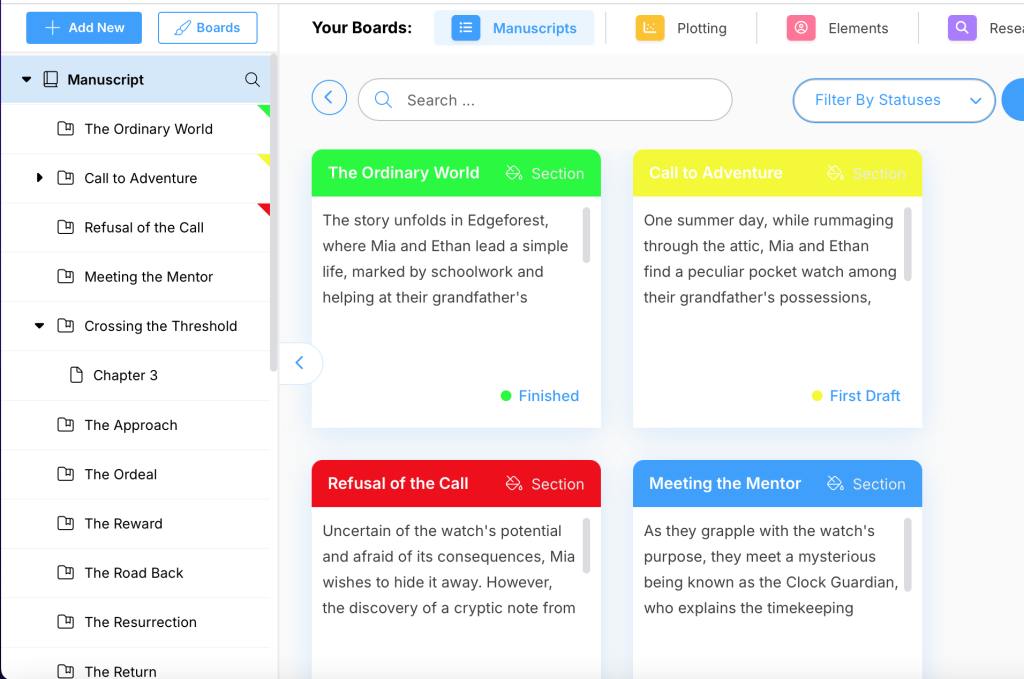
Story Outline Templates
LivingWriter has various story structure templates to choose from when starting a new manuscript. Whether for a novel or screenplay, these templates really help you keep your plot on course and ensure your pacing is good.

Here is a quick look at the templates you can pick from:
- Story Circle
- Hero’s Journey
- Seven Point Story
- Romancing the Beat
- Save the Cat
- PhD Thesis
- Memoir
- Biography
- Self Help
- Book Proposal
- 3 Act Film
- Screenplay Circle
Smart Elements
LivingWriter brings your characters into your story like nothing else does. When you type the name of a character or location, the software recognizes it and pulls it in like a link—clicking the “link” will display descriptions, nicknames, relationships, and pictures for that element.

If you were to click the element, you’ll see all the info you’ve entered for it. This makes keeping up with character arcs and motivations a breeze compared to less innovative methods.

AI Tools
LivingWriter has a handful of useful, cutting-edge AI features, such as outline generation, AI rewrite, and tone analysis, that enhance your writing and make your life easier without actually writing for you. One particularly useful tool for book-to-movie adaptions is the “AI chapter to screenplay” feature.
It allows you to convert chapters of your novel manuscript into a screenplay. Right-click the chapter you want, and click convert to screenplay. The AI will transform the entire chapter into a screenplay scene. The ability to pick and choose which sections of the manuscript to convert is essential, as much of the content in a novel won’t make it to the screen.
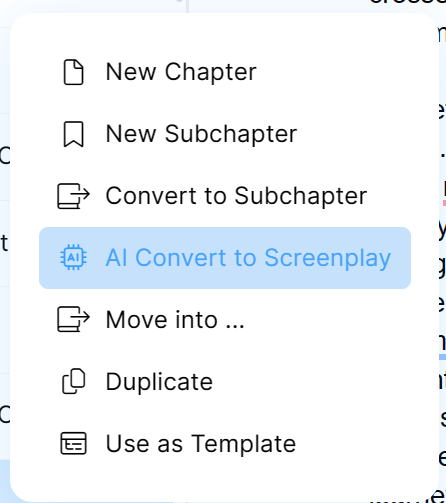
After you click “AI Convert to Screenplay,” the AI will convert your chapter into screenplay form. Depending on how long the chapter is, this may take up to 60 seconds to finsh. Once finished, you’ll have a screenplay version of the entire chapter.
Here is an example from my larger article on the feature, which is linked at the top of the section:
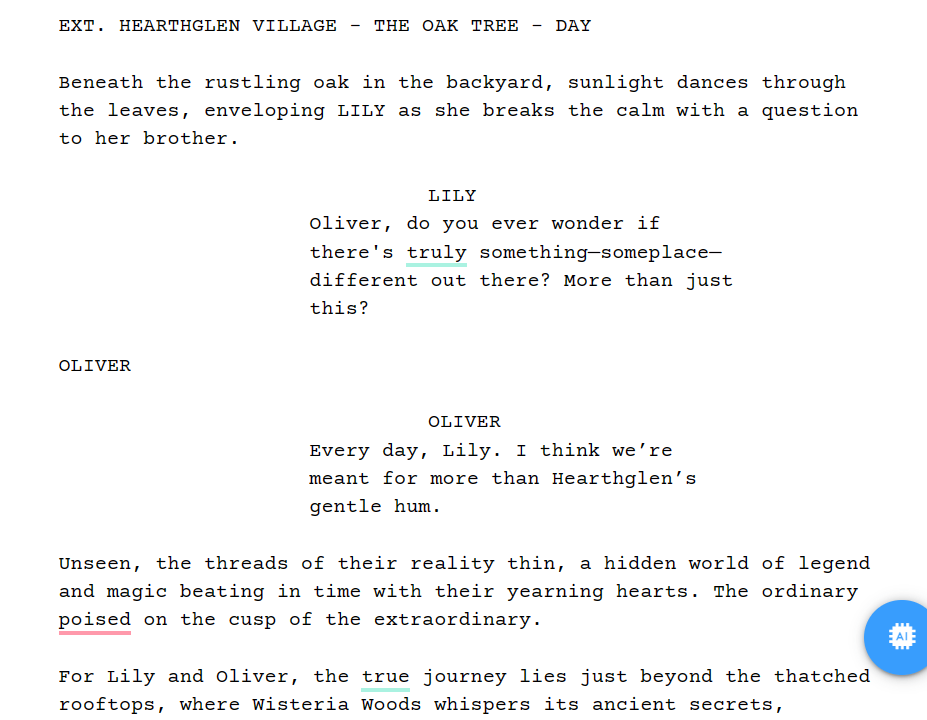
Afterward, the screenplay version of each chapter is found in the same manuscript, right beneath the original, so it’s easy to find and navigate between the two.
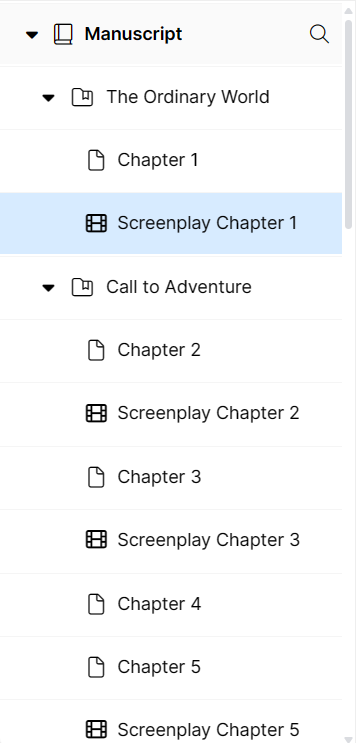
Being able to convert single chapters is helpful since a lot of a novel won’t make it into the screenplay. Furthermore, this helps you figure out exactly which scenes belong in the script and focus on/select only those.
You May Also Like: How To Turn A Novel Into A Screenplay: 4 Simple Steps
Conclusion
There you have it, my friends, the best movies based on books, what makes them the best movie adaptations of all time, and some ones that missed the mark. Now I want to hear from you: what are your favorite movie adaptations of all time, and do you agree with my list? Comment below and let me know.